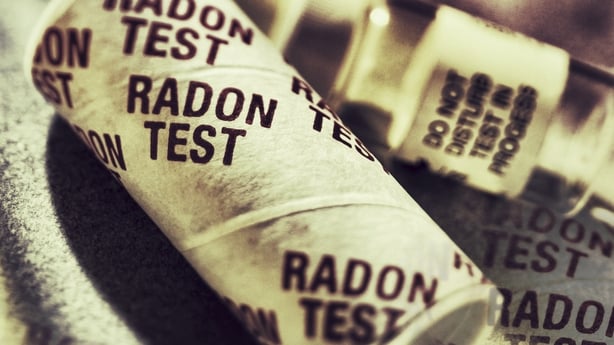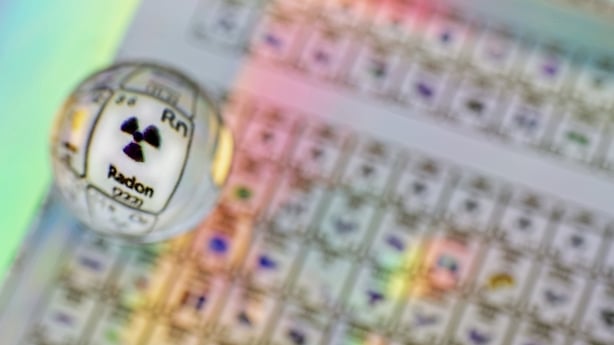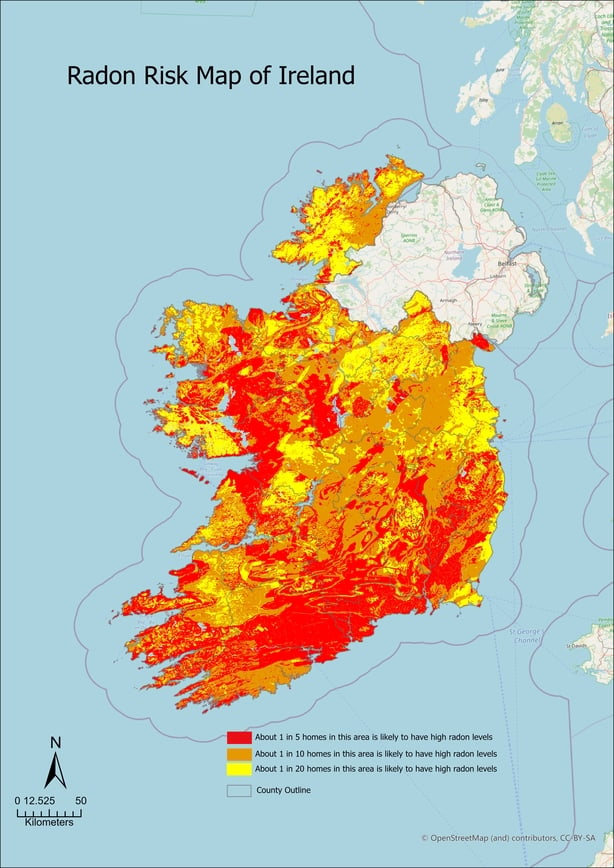For the first time in 20 years the Environmental Protection Agency (EPA) has published an updated radon risk map for Ireland.
The naturally-occurring radioactive gas is linked to 350 new cancer cases every year and the EPA has urged homeowners to test for it.
But what is radon and how can homeowners protect against it?
What is radon?
Radon is a colourless, odourless and tasteless radioactive gas. It is released by the decay of uranium in rocks and soils.
If enough is breathed in over a long period of time it can damage DNA in the lungs and increase the risk of lung cancer.
It is linked to 350 new cases of lung cancer per year, with smokers especially at far greater risk.
In the open air, radon is harmless. But in an enclosed space such as a house, it may build up to an unacceptably high level.
How does it get in?
Radon from the ground enters buildings chiefly through cracks in floors or gaps around pipes or cables.
Various factors such as geology, how a house was built and ventilation all influence the amount of the gas entering a building.
The distribution of radon nationally is largely determined by geology.
Certain types of rock and deposits - including some granites, limestone and shales - tend to be associated with high radon emissions.
How to test for radon?

Radon testing is simple and inexpensive – it involves placing two radon detectors, one in a bedroom and the other in a living room.
The detectors are left in place for at least three months because of significant day-to-day variations in radon levels.
After three months the detectors are sent for analysis before the results are returned.
The EPA strongly recommends that all tests are carried out when a home is occupied rather than when a home is vacant as the flow of ventilation in unoccupied homes will be lower.
This is because less ventilation in a building allows a greater build-up of the gas and so could result in an artificially high reading.
Radon levels in Irish homes vary widely from area to area and even from house to house.
The latest EPA map shows homes in Munster and Connaught in particular are at increased risk, with high radon levels likely in as many as one in five homes in much of these provinces.
The EPA website provides a list of registered radon testing services.
How is it measured?

Radon is measured in becquerels per cubic metre of air (Bq/m3).
According to the EPA, the average indoor radon level in Irish homes is 77 Bq/m3.
If home radon results are below 200 Bq/m3 there is no need to re-test unless major refurbishment work is carried out.
If radon results are above 200 Bq/m3, the EPA recommends carrying out remediation work to reduce the levels.
How can I fix a radon problem?
Home or workplaces built after 1 July 1998 the building regulations require that that they are fitted with a standby radon sump - a simple pipe work that extends from under the foundations into the outdoor air.
If high radon levels are measured, the standby sump can be activated by adding a fan.
Speaking on RTÉ's Morning Ireland, Eugene Monaghan of All Clear Radon said he has come across homes where people have died from lung cancer due to high radon levels.
He said the highest radon levels are found in Waterford, Cork and counties along the western seaboard.
Mr Monaghan said for most homes, the solution is the installation of a radon extraction fan which draws radon from underneath the ground and "blows it off into the atmosphere."
He said it is generally easily installed and is extremely effective.
"Some houses may require two. You are talking in the region of €1,000 and €2,000," he said.
For homes or workplaces built in high radon Areas the installation of a radon membrane in the fabric of the buildingas well as a standby sump is required.
Other ways to reduce radon in the home is to increase indoor ventilation by installing wall vents or window trickle vents on the ground floor, which the EPA says should cost "a few hundred euros."
Radon remediation work may qualify for the Government's Home Renovation Incentive scheme, which lets homeowners, landlords and local authority tenants claim tax relief on works completed by a tax-compliant contractor and subject to 13.5% VAT.
The EPA provides a free post-remediation service to homeowners.

Who's responsible?
The EPA points out that employers in high-radon areas are legally obliged to test their workplaces to ensure employees are protected from exposure to this radioactive gas.
By law, all schools in high radon areas must also be tested.
At present here is no legal requirement for landlords to test their rented homes for radon or to reduce it if the levels are high.
The EPA’s new radon map can be viewed on its website.
By entering an Eircode or address in the search bar, it is possible to determine whether a home is in an at-risk area.

